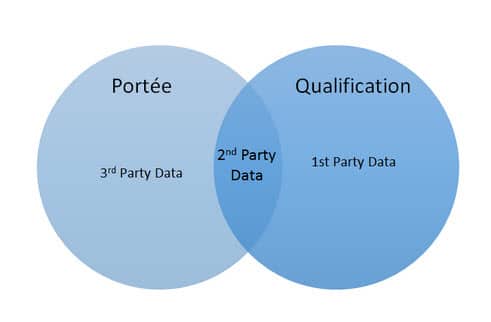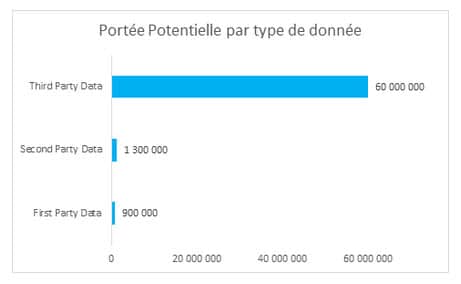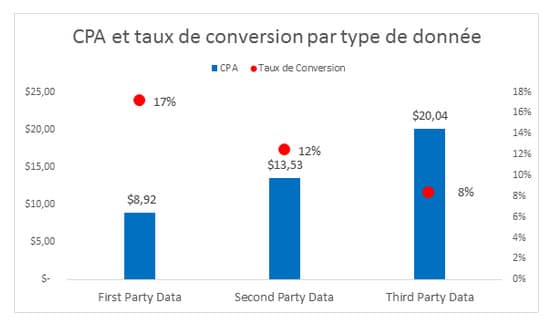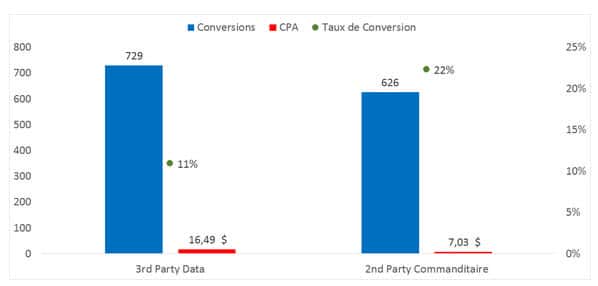Media Senior Director, Partner
2nd Party Data, or how to take advantage of your partnerships for your digital media campaigns
Media Senior Director, Partner
WHAT IS 2ND PARTY DATA?
2nd Party Data is literally another advertiser's 1st Party Data. Usually, this data is made available through a partnership between these two advertisers. It can be two partners offering complementary products (eg airline and credit card company), or two partners with a very similar target (luxury car manufacturer and golf club company). Following this partnership, it is possible to implement its retargeting pixels on the partner's site or to share these audiences via your DMP (Data Management Platform) in order to use them.
To learn more about the different types of Data
TWO ADVANTAGES OFFERED BY 2ND PARTY DATA
1. INCREASE YOUR REACH, WHILE REMAINING VERY SKILLED IN YOUR TARGETING
By default, 3rd Party Data is the audience type with the greatest potential reach. This type of data allows you to reach future new customers. As these audience segments are made up of users from multiple sources, their size will consequently be much larger. The most generic 3rd party audiences can contain hundreds of millions of uniques. The qualification of the audience will however inevitably be lower, because a certain proportion of the pool will not meet the criteria defining your target (age, market, income, etc.).
As for your 1st Party Data audiences (cumulated via your website or your CRM), their size will undoubtedly be smaller, since you are retargeting segments made up of customers or users who already have a certain interest in your products or services. However, the qualification of your audiences will definitely be greater.

For its part, the 2nd Party Data also allows you to reach new customers. In addition, you will maintain excellent audience qualification since this is 1st Party Data from another advertiser or publisher. As you reach new users, it is more relevant for you to analyze the performance of 2nd Party Data in comparison to your 3rd Party Data audiences.
During a recent advertising campaign, we made use of 2nd Party Data. Here's the potential reach of similar segments, but from different audience types:

3rd Party Data had the highest potential reach with 60 million potential uniques during the campaign period. As for 2nd Party Data, it offered us the potential to reach 1.3 million additional users with many characteristics in common with the 1st Party audience.
Following the campaign, we analyzed the results by type of audience and obtained an excellent performance with the audience of the 2nd Party.
Comparing 2nd Party Data with 3rd Party Data, we saw an increase in engagement with a 50% higher conversion rate and an increase in efficiency with a 32% lower CPA.

In conclusion, the use of 2nd Party Data allowed us to increase the overall reach of the campaign to reach new users while contributing positively to the performance of the campaign.
2. INCREASE THE RELEVANCE OF YOUR PARTNERSHIPS
If your company is a partner or sponsor of an event (sports tournament, trade show, festival or other), adding an audience exchange to your agreement can be very effective. A large proportion of event visitors will have previously visited the website in order to learn about the content of this event. Your audience will therefore be made up of a large proportion of the visitors to the event. In addition, your role as a partner or sponsor provides you with a form of visibility on the site, whether through display or promotion in the field.
By using the 2nd Party audience of this event, you have the possibility to reach your target at different points of contact. By retargeting them on the web, you can redirect them to your website and thus maximize your conversion potential.
In the same campaign shown in the previous example, we also had a 2nd Party Data audience made up of visitors to the event website where our advertiser was acting as a partner.

The 2nd Party audience generated about 100 fewer conversions than our 3rd Party Data audience. However, the conversion rate was twice as high on the 2nd Party audience and it generated a 57% lower CPA than the 3rd Party Data audience.
In summary, the use of 2nd Party Data generates a volume similar to 3rd Party Data, but at a cost more similar to 1st Party Data. This audience is also highly qualified due to its higher conversion rate. Thus, you are able to achieve excellent performance while helping to make your partnerships and sponsorships more effective.
3. TEST THE VALUE OF YOUR SPONSORSHIPS
Let's assume that you are a large company that has invested in advertising on the Bell Center tape during a Canadiens game. How do you measure the impact of this advertising on the perception of your brand? A few years ago, it would have been difficult to quickly and quantifiably assess the impact of your sponsorship. With the use of 2nd Party Data, you are now able to assess the relevance of such a sponsorship.
By using audience data from the Canadiens website, you are able to retarget a pool of users who have been exposed to your advertising (via the broadcast of the game or by having been present at the Bell Centre). If your performance, as presented in the previous example, is higher than your campaign average, you are able to identify that there is an affinity link between your brand and the target audience. Thus, you have validation that your sponsorship contributes positively to the perception of your brand and the consideration of your products and/or services offered.
Thus, the use of this type of data contributes not only to the acquisition of new customers, but also to demonstrate, with supporting data, that your sponsorships contribute positively to developing the notoriety of your brand.
WHERE TO START?
IDENTIFY QUALITY PARTNERS
Before entering into a data sharing agreement, it is important to identify key partners with quality audiences. It is therefore necessary to take into account the way in which the partner accumulates its audiences, the volume of the desired audiences as well as the qualification of these. By looking for a partner offering a complementary product or service (e.g. credit card company and airline), or having a target similar to yours (e.g. luxury car manufacturer and golf club manufacturer), you will increase your chances of success. There is no point in carrying out a multitude of exchanges of audience data if the size of the audiences is insufficient or if a good proportion of the audiences is made up of users who do not represent your primary target.
USE THE RIGHT TOOLS
In order to be able to adequately segment the visitors of your site into relevant audiences, it is strongly recommended to implement a tag manager. This tool offers you great flexibility on the implementation of tags (tag based) and on the creation of audiences generated by rules ( rule based ).
With the use of several programmatic platforms and the accumulation of a multitude of data that can be used for marketing purposes, it is much more efficient to group all audiences under one platform. It is therefore strongly suggested to equip yourself with a DMP (Data Management Platform) . This is an essential tool to ensure effective audience management.
In conclusion, the use of 2nd Party Data offers a multitude of advantages to advertisers. You will thus be able to obtain better results in your digital campaigns and generate more acquisitions, increase the value of your partnerships and be able to identify the value and relevance of your sponsorships.



.jpg)




